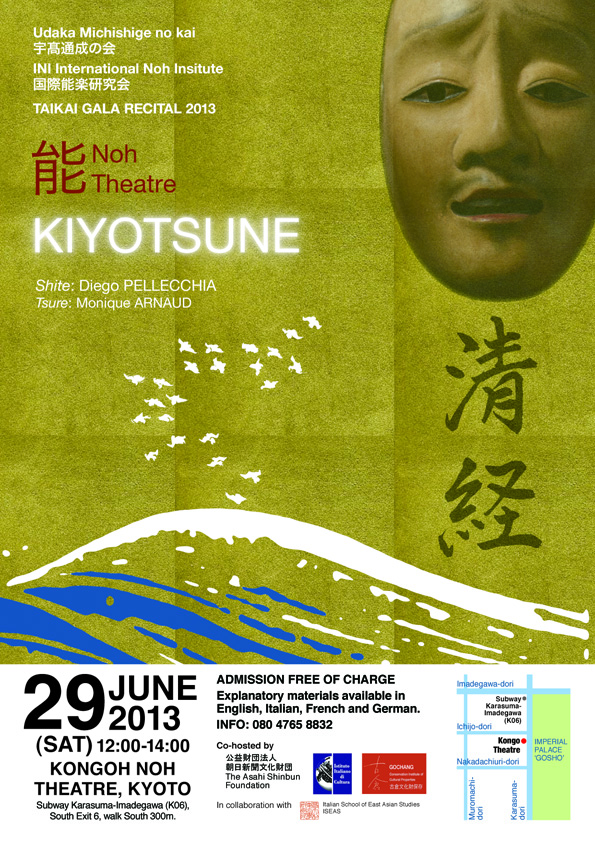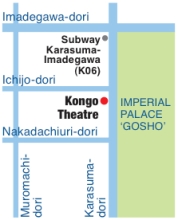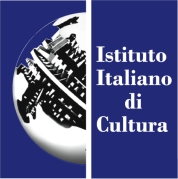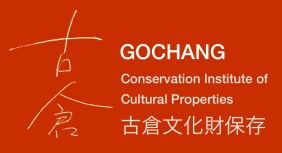A beautiful video digest of the 2018 Heian Jingū Takigi Noh, the open-air, torch-lit noh performance taking place at Heian Shrine every year on June 1-2. Udaka Michishige is featured performing Hashi Benkei from min. 1:15. Check it out!
Udaka
Noh Kinsatsu, Yoshino Shizuka at the Kongō Noh theatre.
 On February 25th (Sunday) 2018 two noh plays, Kinsatsu and Yoshino Shizuka will be performed at the Kongo Noh theatre in Kyoto.
On February 25th (Sunday) 2018 two noh plays, Kinsatsu and Yoshino Shizuka will be performed at the Kongo Noh theatre in Kyoto.
Kinsatsu (shite: Teshima Michiharu) is a first category (god noh) play, not performed frequently. The main character is the demon-quelling deity Amatsu Futodama, appearing with bow and arrow in the second half of the play. (Illustration: Kinsatsu, by Tsukioka Kogyo)
Yoshino Shizuka (shite: Udaka Tatsushige) is a third category (women noh) play, centering on the figure of the shirabyoshi dancer Shizuka Gozen, lover of Minamoto no Yoshitsune.
Kei’un-kai Memorial Performance 17 August 2014

The International Noh Institute
On 17 August 2014 from 9:30am the Kei’un-kai (the group Udaka Michishige’s students, incuding the International Noh Institute) will hold a Memorial Performance at the Kongō Noh Theatre in Kyoto. The performance will begin with two bangai shimai or special feature dance excerpts by masters Taneda Michikazu (Eguchi) and Udaka Michishige (Fujitō), followed by a recitation of an excerpt from the Noh Seigan-ji by Udaka Michishige’s sons, Tatsushige and Norishige. Student performances will begin at 9:50 and will feature a number of shimai, maibayashi and two full Noh plays (from 13:00 Atsumori, Shite: Nagao Atsushi; from 17:00 Funa Benkei, Shite: Higaki Takafumi).
ADMISSION FREE: feel free to come and go quietly. An English synopsis of the program will be available. Download here the full program (Japanese only).
Members of the International Noh Institute will perform the following dances:
Elaine Czech (イレーイン・チェック) shimai:
View original post 29 more words
[Extended] Noh Mask Carving Atelier – Special Opening (February 2014)

Due to popular demand the Special Opening of Udaka Michishige’s Noh Mask Carving Atelier has been extended. We have received many requests of Japanese and non-Japanese, Kyoto residents and Kyoto visitors who wished to learn about the world of Noh masks from the direct experience of a professional carver and actor such as Udaka Michishige.
Three new dates (February 6th, 20th and 27th) have been added. There are two time slots: afternoon (14:00~17:00) or the evening (18:00~21:00).
This is a great opportunity for those interested in masks and in the mask-making process, as well as in the use of the masks in actual performance: Michishige is the only Noh actor who is also a skilled mask carver, regularly using his own masks on stage. In 2010, Michishige published the photobook The secrets of Noh Masks (Kodansha/Oxford) with photographer Shuichi Yamagata. I have posted more about Michishige’s activities as mask carver here.
If you are in Kyoto don’t miss this chance to be introduced to the world of Noh masks – both Japanese and English speakers are welcome!
Observers are admitted FREE OF CHARGE
Udaka’s atelier is just a few minutes on foot from the Kokusai-kaikan subway stop (Karasuma line). To reserve a place, or for more information, please feel free to contact me here.

[EVENT]: Internationalisation of Japanese Traditional Performing Arts

On January 8th 2014 the ARC Art Research Centre at Ritsumeikan University will host the event ‘Internationalisation of Japanese Performing Arts – Noh as Culture of the World’. The event combines performance, theory and discussion. See below for details (in English and Japanese).
The first part features shimai dance excerpts by masters of the Kongo School of Noh Udaka Michishige (Sanemori), Udaka Tatsushige (Yashima) and Udaka Norishige (Tomoe). I will also perform a shimai under my stage name Takaya Daigo (Atsumori – kiri). In the second part of the event I will showcase my current research: ‘The role of amateurs in the world of Noh’, as a work-in-progress. In this lecture I will explore the various kinds of amateur practitioners that populate the cultural world of Noh and how their social, economic and political role has changed throughout history. Unlike other kinds art professionals, most Noh performers depend on teaching amateurs in order to socially and financially sustain their artistic activities. Noh is currently undergoing a difficult phase in its history, with dwindling audiences and a lack of young blood among its professional ranks. In order to look for trajectories of solution to these issues, I believe that is necessary to consider the role of amateurs as one of the pillars on which the Noh world is based, and understand the complex relationship between audience, amateurs, and professionals. In the third part of the afternoon I will invite Udaka Michishige to discuss the role of amateurs in his experience as Noh actor and leader of the Kei’un-kai and of the INI International Noh Institute.
Internationalisation of Japanese Performing Arts
– Noh as Culture of the World –
January, 8th 2014 (Wednesday)
Ritsumeikan University, Kinugasa Campus
Art Research Center
Programme:
16:00 Opening remarks
16:40 Performance (shimai)
Atsumori – kiri Takaya Daigo
Tomoe Udaka Norishige
Yashima Udaka Tatsushige
Sanemori Udaka Michishige
17:00 Intermission
17:10 Lecture – The role of amateurs in the world of Noh -Diego Pellecchia (Visiting Researcher, Art Research Centre, Ritsumeikan University).
17:45 Udaka Michishige and Diego Pellecchia in conversation
18:30 Closing remarks
The event is open and free of charge
Matsuyama Shimin Noh 2014 – Aoinoue mumyo no inori
Next Sunday (November 3rd, which is both my birthday and the ‘culture day’ in Japan) I will take part to the Matsuyama Shimin Noh performance at the Yamatoya Honten Noh stage in Matsuyama, Shikoku. The event begins at 10:00 with a recital (entry free of charge), featuring Udaka Michishige’s students. I will perform a shimai, or dance excerpt, from the Noh Uta-ura, and will sing in the su-utai chanting of the Noh Kogō. The main event will be Udaka-sensei’s performance of Aoinoue in the ‘mumyō no inori’ kogaki, or variation. I am lucky enough to have a privileged observation spot, serving in the ji-utai chorus for this performance.
Every year in November Udaka Michishige takes the shite main role at the Matsuyama Shimin Noh performance. Although based in Kyoto, Udaka regularly teaches both utai/shimai and mask carving in Nagoya, Okazaki, Tokyo, Yokohama, and Matsuyama in Shikoku, the area where his family originally comes from. He is a descendent of two Shikoku families: Udaka and Kawada. The Udaka family had a castle in Niihama City during the medieval period and later served the Matusdaira clan feudal lords in Matsuyama as Noh actors from 1712 until the start of the Meiji period.
For this year’s shimin Noh we are giving away 2 free tickets to the first two people who contact us so make sure not to miss this chance if you are in Matsuyama next weekend! Find contact details below.
Aoinoue
Based on an episode from the Tale of Genji, the 11th century masterpiece by Murasaki Shikibu, the main character is not Lady Aoi, the wife of Prince Genji, but Lady Rokujo, the most intriguing female character in the novel. Once Genji’s lover but now abandoned by him and filled with resentment towards his wife after a humiliating incident at the Kamo Festival where her coach was forced out of its viewing spot by Lady Aoi’s retainers, Lady Rokujō’s living spirit torments her rival. A shamaness is sent to discover the source of the possession of Lady Aoi and then an exorcism is performed by the priest Kohijiri, finally bringing Rokujo to her senses by calling on the power of the Buddhist sutras. In the mumyō no inori kogaki or ‘Exorcism in Spiritual Darkness Variation’, the robe used to represent Lady Aoi is white rather than red, and Lady Rokujo leaves the stage for a change of costume rather than retreating to the koken-za stage attendants’ seat for only a change of mask. She returns in nagabakama, long vermillion trousers, often with a Nagakamoji, an extension of the wig that emphasises that Lady Rokujo’s is a noblewoman, increasing the sense of horror at the intensity of the expression of her jealousy in choreography also more graphic than in the standard production.
(Text by Rebecca Teele Ogamo)
Ehime University Noh Club
Udaka Michishige has taught students of the Ehime University Noh Theatre Club for over 30 years. Club activities include the practice of Noh chant and dance as well as workshops and performances. Every year in November club members join other students of Udaka at Matsuyama Municipal Noh Performance. Lessons are held both in Japanese and in English. Email: Kmct1q_es@ezweb.ne.jp
For information please contact:
KYOTO
Keiun-kai INI Main Offices, Training Center
111 Satta-cho, Kami-takano, Sakyo-ku, Kyoto 606-0047
Tel: (075)701-1055
Fax: (075)701-1058
Email: ogamo-tr@mbox.kyoto-inet.or.jp (c/o Rebecca TEELE-OGAMO)
MATSUYAMA
Matsuyama Keiun-kai Shikibutai
Yamagoe 4-chome 11-38, Matsuyama, Ehime
Tel/Fax: (089) 924-8554
Rare Play: ‘Hoso’ 彭祖 to be performed in Kyoto

On Sunday 27th October 2013 Kongō-ryu shite actor UDAKA Michishige will perform the rare Noh Hōso, exclusive to the Kongō school of Noh, as part of the Kongo Noh Theatre monthly programme. The Noh Yōkihi and the Kyogen Hagi Daimyō will also be performed on the day.

Noh: Hōso 彭祖
Celebrations are being held at the court of Gi no Buntei in China and among the many immortals who come from their mountain hermitages to pay their respects is one who appears to be a young boy but calls himself ‘Hōso’, the ‘Prosperous Ancestor’. Asked about his identity, he tells how he was once in service at court but was exiled long ago for the crime of stepping over the Emperor’s pillow. In his compassion the Emperor gave the youth the pillow as a keepsake along with a quotation from the Kannon Sutra. Hōso explains that he was acquired eternal youth by drinking the water from the stream running by his hut. Hōso faithfully copied the quotation on the leaves of chrysanthemums which grew by his hut and dew that fell from them transformed the stream into an elixir. The emperor vows to visit Hōso’s hermitage on Mt. Tekken and later Hōso dances for him there.
Hōso is the sequel to Makura Jidō (titled Kiku Jidō in the Kanze school version) in which the young boy is discovered in his place of exile and he first realises that he has become an immortal, thanks to the power of the quotation he has copied on the chrysanthemum leaves. Hōso is performed only by the Kongō school.
(Text: Rebecca Teele Ogamo)
Kongo Noh Theatre, Kyoto. Monthly performance series (October).
- Noh Yōkihi: Matsuno Yasunori
- Kyogen Hagi Daimyō: Shigeyama Akira
- Noh Hōso: Udaka Michshige
Doors open at 13:00, performances start at 13:30.
Tickets: Advance booking: 5,500yen At the door: 6,000yen Students: 3,000yen
For more information on the performance, or to reserve tickets, please contact me here.
14th ‘Seiran Noh’ – MIDARE, FUTARI SHIZUKA
The Seiran-Noh (青蘭能) is a yearly performance at the Kongo Noh theatre in Kyoto featuring Udaka Michishige and his sons, Udaka Tatsushige and Udaka Norishige. Until now known as ‘Seigan Noh’, the event has recently changed its name into ‘Seiran’ honouring Udaka Michishige’s great-grandfather, painter Kawada Shoryo (1824-1898), who was closely related to Sakamoto Ryoma, one of the central characters in the Meiji restoration. Kawada’s favourite flower was the orchid (‘ran’ 蘭).
See below for ticket reservation
This year’s Seiran Noh (8 September 2013) features the Noh Midare, a special variation (kogaki) of the Noh Shōjō in which the midare-ashi a particularly unusual and challenging dance, is performed instead of the usual chu-no-mai medium tempo dance. Midare is a hiraki-mono, one of the plays marking a performer’s passage into a new phase of their career. This year Udaka Norishige will perform Midare, follow ing his father and elder brother’s steps.
The second play is Futari Shizuka, (‘Two Shizukas’), a third category play based on happenings and characters from the Genpei War tales. The special feature of this play is the instrumental dance performed by identically dressed shite and shite-tsure: the spirit of Minamoto no Yoshitsune’s lover Shizuka Gozen and a woman possessed by her. Futari Shizuka will be performed by Udaka Michishige and his eldest son, Udaka Tatsushige.
8 September 2013・The 14th Annual Udaka Seiran Noh Performance
Kongo Noh Theatre 1:30~5:00 p.m. (doors open at 1:00p.m.)
Noh: FUTARI SHIZUKA
Shite: UDAKA Michishige, Tsure: UDAKA Tatsushige
Kyogen: KURI YAKI
Shite: SHIGEYAMA Shime, Ado: SHIGEYAMA Motohiko
Noh: MIDARE
Shite: UDAKA Norishige
Tickets: Center Reserved Seats 7,000 yen, Side Reserved Seats 6,000 yen, General Admission Mid-center Seats 5,000 yen, Student, General Admission Mid-center Seats 2,000 yen
Synopses of the plays will be available at the theater in English, French, German, and Italian.
Contact me for information and ticket reservation
Fukyu Noh HASHI-BENKEI 7 July 2013
On Sunday 7 July 2013 at 17:00 the Iemoto Kongo Hisanori will perform the Noh Hashi-Benkei at the Kongo Noh Theatre in Kyoto. The performance is offered at the special price of 2,500yen with advanced booking so don’t hesitate to contact me if you want to reserve a ticket.
“Warrior-monk Musashibo Benkei has been warned that a young boy is attacking passersby at Gojo Bridge in the capital and taking their swords. Benkei is determined not to be frightened by such rumors and refuses to avoid the area. He goes to the bridge and sees there what seems to be the form of a young woman. In fact it is Ushiwaka, later to be known as Minamoto no Yoshitsune, a leader of his clan, who has made a vow to collect 1,000 swords, coming down from Mt. Kurama where his mother has ordered him to stay. The two fight, but Ushiwaka cleverly triumphs over Benkei who then becomes his faithful retainer.” (Summary by Ogamo Rebecca Teele)
Fukyu-Noh is a regular summer event aimed at introducing Noh to young/new spectators. The Noh will be preceded by a greeting from our teacher, Udaka Michishige (Vice-Director of the Kongo-kai) and by a short explanation by Prof. Ono Yoshiro (Kyoto Institute of Technology).
Kiyotsune 29 June 2013

I am pleased to announce that on 29 June 2013 I will take shite lead role in the Noh Kiyotsune「清経」on the Kongo Noh Theatre stage, in Kyoto, Japan. This will be my first performance as shite in a full Noh production. The event is part of the INI International Noh Institute 2013 Gala Recital, featuring other performances by Japanese and international students of Udaka Michishige, and is co-hosted by the Asahi Shibun Foundation, the Istituto Italiano di Cultura, and Gochang Conservation Institute of Cultural Properties, in collaboration with ISEAS Italian School of East Asian Studies. I will post more on Kiyotsune during the following weeks, so watch this space for updates on rehearsals, thoughts, and pictures!
I look forward to meeting you all on 29 June 2013 in Kyoto!
Udaka Michishige no Kai 宇髙通成の会 INI – International Noh Institute 国際能楽研究会
The International Noh Institute Taikai Gala Recital 2013
Kiyotsune
29 June 2013 12:00-14:00
Kongo Noh Theatre, Kyoto
Shite: Diego PELLECCHIA, Tsure: Monique ARNAUD
FREE ADMISSION Explanatory materials available in English, Italian, French and German. Kongo Noh Theatre Subway Karasuma-Imadegawa (K06), South Exit 6, walk South 300m.
The event is co-hosted by:
The Asahi Shinbun Foundation
公益財団法人 朝日新聞文化財団
in collaboration with












